Cranes safety:
Introduction:
A crane is a tower or derrick that is equipped with cables and pulleys that are used to lift and lower material. They are commonly used in the construction industry and in the manufacturing of heavy equipment. Cranes for construction are normally temporary structures, either fixed to the ground or mounted on a purpose built vehicle.
They can either be controlled from an operator in a cab that travels along with the crane, by a push button pendant control station, or by radio type controls. The crane operator is ultimately responsible for the safety of the crews and the crane.
Various Types Of Cranes:
Mobile Cranes
The most basic type of crane consists of a steel truss or telescopic boom mounted on a mobile platform, which could be a rail, wheeled, or even on a cat truck. The boom is hinged at the bottom and can be either raised or lowered by cables or hydraulic cylinders.
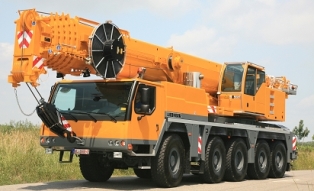
Telescopic Crane
This type of crane offers a boom that consists of a number of tubes fitted one inside of the other. A hydraulic mechanism extends or retracts the tubes to increase or decrease the length of the boom.
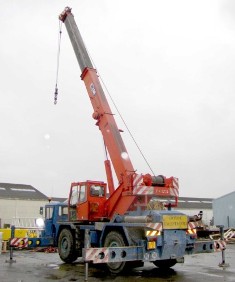
Tower Crane
The tower crane is a modern form of a balance crane. When fixed to the ground, tower cranes will often give the best combination of height and lifting capacity and are also used when constructing tall buildings.
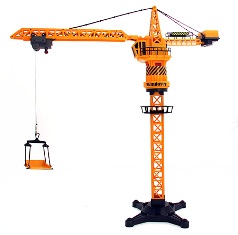
Truck Mounted Crane
Cranes mounted on a rubber tire truck will provide great mobility. Outriggers that extend vertically or horizontally are used to level and stabilize the crane during hoisting.
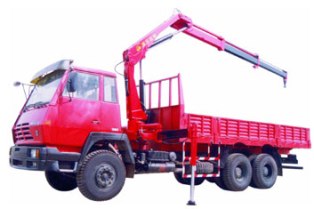
Rough Terrain Crane
A crane that is mounted on an undercarriage with four rubber tires, designed for operations off road. The outriggers extend vertically and horizontally to level and stabilize the crane when hoisting. These types of cranes are single engine machines where the same engine is used for powering the undercarriage as it is for powering the crane. In these types of cranes, the engine is normally mounted in the undercarriage rather than in the upper portion.
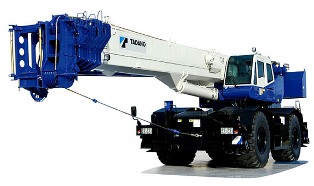
Loader Crane
A loader crane is a hydraulically powered articulated arm fitted to a trailer, used to load equipment onto a trailer. The numerous sections can be folded into a small space when the crane isn’t in use.
Overhead Crane
Also referred to as a suspended crane, this type is normally used in a factory, with some of them being able to lift very heavy loads. The hoist is set on a trolley which will move in one direction along one or two beams, which move at angles to that direction along elevated or ground level tracks, often mounted along the side of an assembly area.
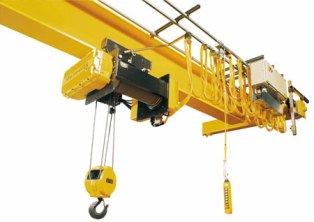
In the excavation world, cranes are used to move equipment or machinery. Cranes can quickly and easily move machinery into trenches or down steep hills, or even pipe. There are many types of cranes available, serving everything from excavation to road work.
Cranes are also beneficial to building bridges or construction. For many years, cranes have proven to be an asset to the industry of construction and excavating. Crane operators make really good money, no matter what type of crane they are operating.
Types of mobile cranes:
Truck Mounted variable boom
Truck Mounted fixed boom
Crawler Mounted variable boom
Crawler Mounted fixed boom
Wheel Mounted Vari. boom
Wheel Mounted fixed boom
Types of Over head cranes:
Gantry crane
Jib crane
Mono rail crane
Over bridge crane
Top run bridge crane
underhung bridge crane
Types of Tower cranes:(Wide varities)
Mono Tower
Inner & Outer tower
Telescopic tower
A frame jib tower
Articulate jib tower
Climbing tower
Crawler tower
Fixed Luffing jib tower
Luffing jib tower
Truck Mounted tower
Wheel Mounted tower
Saddle & fixed jib tower
General Requirements:
The will establish crane safety operational procedures through the use of this document. This standard practice instruction applies to cranes used in conjunction with other material handling equipment for the movement of material. The types of cranes covered.
Initial Training:
Training shall be conducted prior to job assignment. This employer shall provide training to ensure that the purpose, function, and proper use of cranes is understood by employees and that the knowledge and skills required for the safe application, and usage is acquired by employees. This standard practice instruction shall be provided to, and read by all employees receiving training.
Training shall include, as a minimum the following:
1 Pre operational inspection requirements of the crane to be used.
2 Specific operational requirements of the crane to be used.
3 Principals of crane operations.
4 Recognition of applicable hazards associated with the work to be completed.
5 Load determination and balancing requirements.
6 Procedures for removal of a crane from service.
7 All other employees whose work operations are or may be in an area where cranes may be utilized, shall be instructed to an awareness level concerning hazards associated with cranes.
Physical and mental requirements of operators. Crane operators will be screened for physical and mental impairments that could result in a improper use. Operators will meet as a minimum, the following requirements before being certified to operate cranes.
- Be drug and alcohol free during any lifting event.
- Be thoroughly trained in all facets of the required lift.
- Have a mature and safe attitude at all times.
- Have good depth perception (essential for load spotting).

- Have good hearing and vision (corrected or uncorrected).
- Have no history of unsafe acts in the workplace.
- Have the ability to react quickly in an emergency.
- Take no medication that will interfere with the operation.
- Understand the requirements for all phases of the lift.
Certification. This employer shall certify that employee training has been accomplished and is being kept up to date. The certification shall contain each employee's name and dates of training.
Safe Operating Practices for Operators:
Whenever any crane is used, the following safe practices (as a minimum) shall be observed:
1. Always check warning devices and signals before use.
2. Always document and maintain inspection records.
3. Always ensure cranes shall not be loaded in excess of their rated capacities.
4. Always ensure the new location support the weight?
5. Always keep employees clear of loads about to be lifted and suspended loads.
6. Always keep suspended loads clear of all obstructions.
7. Always lockout before maintenance or repairing cranes.
8. Always position the hook directly over the load before lifting.
9. Always test brakes by a short lift to ensure control.
10. Before being lifted, loads will be checked for proper balance.
11. Follow the manufacturer’s recommendations.
12. Frequently inspect cranes exposed to adverse conditions.
13. Hands must not be placed between the suspension means and the load during lifting.
14. Know where you’re going to set the load down!
15. Know your travel path in advance of the lift!
16. Loads will in all cases be properly balanced to prevent slippage.
17. Move loads only after being signaled by the designated, qualified signaler.
18. Never allow riders on loads or hooks.
19. Never allow unauthorized persons to operate cranes.
20. Never attempt to operate a crane or hoist that is suspected to be unsafe.
21. Never carry loads over workers.
22. Never carry loads past workers (they must yield right of way).
23. Never use a cranes that are damaged or defective in any way.
24. Operators must watch the signalers.
25. Shock loading is prohibited.
26. Signalers must keep line of sight with the operator.
27. Signalers must watch the load.
28. Test all hoist controls and brakes at the beginning of each shift.
Safe Operating Practices for Signalers
Whenever any crane is used, the following safe practices (as a minimum) shall be observed:
1. Ensure that only one person is the designated signaler.
2. Ensure the operator acknowledges every signal.
3. Follow the manufacturer’s recommendations.
4. Know the new location will support the weight.
5. Maintain line of sight with the operator.
6. Operators must watch the signalers.
7. Plan in advance where the load is going!
8. Stop the operation any time comprehension is lost.
Leaving or Parking Hoists or Cranes:
Whenever leaving or parking hoists or cranes, the following safe practices (as a minimum) shall be observed:
- Follow the manufacturer’s recommendations.
- Make a visual check for any dangerous condition.
- Place all controls in the “off” position.
- Place main power switch in the “off” position.
- Raise all hooks to but not through limit switches.
- Report all cranes that are not in operation immediately.
- Report any defects immediately.
- Tag out defective equipment immediately.
Handling Sling Loads:
The following general safe practices (as a minimum) shall be observed when handling slung loads:
1. Always keep hands and fingers clear of untensioned loads.
2. Always keep suspended loads clear of all obstructions.
3. Always keep suspended loads clear of employees.
4. Always pad or protect slings from sharp edges of the load.
5. Always think before you affect a load.
6. Determine the history of the care and usage of the sling.
7. Determine the number of sling legs (if used) and load requirements.
8. Ensure you know rated capacity of the sling.
9. Ensure you know the angle the sling makes with the horizontal line.
10. Ensure you know the size, weight, and center of gravity of the load.
11. Follow the manufacturer’s recommendations.
12. Never load in excess of the rated capacity.
13. Never pull a sling from a suspended load under tension.
14. Never shorten with knots, bolts or other makeshift devices.
15. Never use a sling that is damaged in any way.
Estimating the Weight of Loads:
Lifting will not be conducted until load weights have determined. When estimating load weights operators will stay within 50% of the cranes rated capacity when estimating loads (or manufacturer recommendation). Never attempt a load lift based solely on a guess! The following methods may be used to estimate the weight of loads.
- Check equipment nomenclature plates.
- Check shipping papers.
- Consult with the equipment manufacturer.
- Estimate weight using weights of similar loads.
- Use a dynamo meter.
- Use industry standard tables or charts.
Personal Protective Equipment:
Supervisor will ensure that a Job Hazard Analysis is conducted for specific lifting operations. Operators will use the required PPE in the conduct of lifting operations. Protective clothing and equipment considerations:
- Ensure PPE is appropriate for the particular hazard(s).
- Ensure PPE is kept clean, fully functional, and sanitary.
- Maintained all PPE in good condition..
- Properly store PPE when not in use.
Inspection intervals:
Daily inspections:
Cranes will be inspected each day before being used, the crane will inspected in accordance with OSHA, Consensus Standards, and Manufacturer recommendations.
Periodic inspections:
Supervisors will determine and schedule additional inspections periodically during crane use, where service conditions warrant. A thorough periodic inspection shall be made on a regular basis, to be determined on the basis of, frequency of crane use; severity of service conditions; nature of lifts
being made; experience gained on the service life of cranes used in similar circumstances, & OSHA, Consensus Standards, and Manufacturer recommendations.
Inspection documentation:
Cranes inspections will be documented as having been inspected. Scheduled inspections will be documented as having been conducted.
1. Identify items that were inspected.
2. Show the status of the inspected items.
3. Provide the signature of the inspector.
4. Show the date.
5. File it and maintain it!
6. Review the manufacturers specific inspection requirements!
Daily Checks:
The following items (as a minimum) shall be checked prior to use of any crane:
1. Check for air or hydraulic fluid leakage.
2. Check for load capacity stenciling on both sides of unit.
3. Check for twisted, broken or kinked cables or chains.
4. Check the operation of the crane; controls & movement.
5. Inspect for deformed, cracked, or stretched hooks.
6. Inspect for serviceable safety latches.
7. Observe correct drum spooling as the hook is raised.
8. Operate empty hook till it actuates the upper limit switch.
9. Operate hoist and trolley brakes, ensure no excessive coasting.
10. Visually inspect all units for integrity, leaks etc.
11. Review the manufacturers specific requirements!
Monthly Checks:
The following items (as a minimum) shall be checked monthly:
1. Follow any additional recommendations of the manufacturer.
2. Inspect for twisted, broken or kinked cables or chains.
3. Inspect hooks for cracks, missing or broken parts.
4. Measure hooks for deformation or stretching.
5. Measure lifting chains for excessive stretch, twisting etc.
6. Review the manufacturers specific inspection requirements!
7. Visually inspect all critical items.
8. Review the manufacturers specific requirements!
Periodic Checks:
Review the manufacturers specific inspection requirements! The following items (as a minimum) shall be checked at periodic inspections (1 to 12 month intervals):
1. Interval dependent on the type of activity performed.
2. Interval dependent on the severity of service.
3. Interval dependent on the environmental conditions.
4. As a minimum the inspection should cover:
Chain Or Cable Reeving Hook Condition
Electrification Hoist Drives Travel Drives
Brakes Limit Switches Couplings
Rails Balance Controls
Warning Devices End Stops Signage
Periodic CMAA Inspection Recommendations:
Class description typical schedule
A Standby or infrequent service Annually
B Light service 2-5 lifts hr. Annually
C moderate service 50%capacity, 510lifts hr. Annually
D Heavy service 50%capacity, 1020lifts hr. Semiannually
E Severe service near capacity, 20+ lifts hr. Quarterly
F Continuous severe service near capacity Bimonthly
and continuous service throughout day
Note: Different conditions may suggest different intervals.
New, Idle, Altered, Used Cranes:
The use status of cranes will drive specific requirements for periodic maintenance and servicing. The status of the crane will be determined based on manufacturer recommendations and consultation with specific regulatory standards. Prior to initial or reintroduction into service cranes will be tested and inspected completely using the criteria applicable to periodic inspections. A report will be generated and kept on file for future reference. The manufacturers specific requirements will be reviewed!
Preventive Maintenance:
Preventative maintenance procedures will be developed and used for specific cranes. Maintenance procedures will be determined on the basis of, frequency of crane use; severity of service conditions; nature of lifts being made; experience gained on the service life of cranes used in similar circumstances, and OSHA, Consensus Standards, and Manufacturer recommendations. Typical requirements include:
1. Adjusting the brakes.
2. Adjusting the operation of limit switches.
3. Checking and filling the gear cases to the proper levels.
4. Cleaning and lubricating the wire rope (cable) and load chain.
5. Cleaning or replacing pitted or burned electrical contacts.
6. Cleaning or replacing the air and fluid filters.
7. Inspecting the operation of all controls and warning systems.
8. Lubricating the bearings, gears, pinions, linkages, shafts, etc.
9. Replacing any contaminated oils.
Pro perational Testing Requirements:
Pre-operational tests will be conducted prior to use of any crane. Testing requirements will be determined on the basis of, frequency of crane use; severity of service conditions; nature of lifts being made; experience gained on the service life of cranes used in similar circumstances, and OSHA, Consensus Standards, and Manufacturer recommendations. Typical requirements include:
Pre-operational Tests General:
- Check for obstructions in the travel path of the crane.
- Check upper and lower limit switches.
- Ensure all emergency disconnects are known before any test.
- Ensure that the manufacturers recommendations are followed.
- If you have a checklist follow it!
- If you’re not familiar with the cranes’ operation get help.
- Inspect all electrical controls for proper operation.
- Never unwind the spool completely!
- Observe for smooth operation of the components.
- Test all controls to determine proper operation.
Pre-operational Tests Hooks:
1. Replace if deformation or cracks are found.
2. Check for proper function of the safety latch.
3. Inspect for twists from the plane of the unbent hook.
4. Check for proper swivel.
5. Hook repair is generally not recommended.
6. Emergency hook repair must be performed only under competent supervision.
7. After any hook repairs, the hook must be load tested before being returned to normal service.
Pre-operational Tests Rope:
- Broken or worn outside wires.
- Corroded or broken wires at end of connections.
- Corroded, cracked, bent, worn, or improperly applied end connections.
- Reduction in rope diameter (replace if found).
- Severe kinking, crushing, cutting or unstrapping.
Lockout Tag out Considerations:
Lockout Tag out will be conducted when maintenance or servicing is performed on any crane. Lockout requirements will be determined on the basis of, OSHA, Consensus Standards, and Manufacturer recommendations. Typical requirements include:
1. Review requirements for the individual crane.
2. Integrate lock out and maintenance requirements.
3. Ensure training in adequate for level of maintenance.
4. Ensure written programs are established and reviewed.
5. Carefully select lockout devices, ask the manufacturer for recommendations.
6. Do not necessarily assume devices are interchangeable between different types of cranes.
Click the below link to downloads the different types cranes safety inspection forms

General daily crane inspection check sheet
Monthly crane inspection check sheet
Industrial crane inspection form





